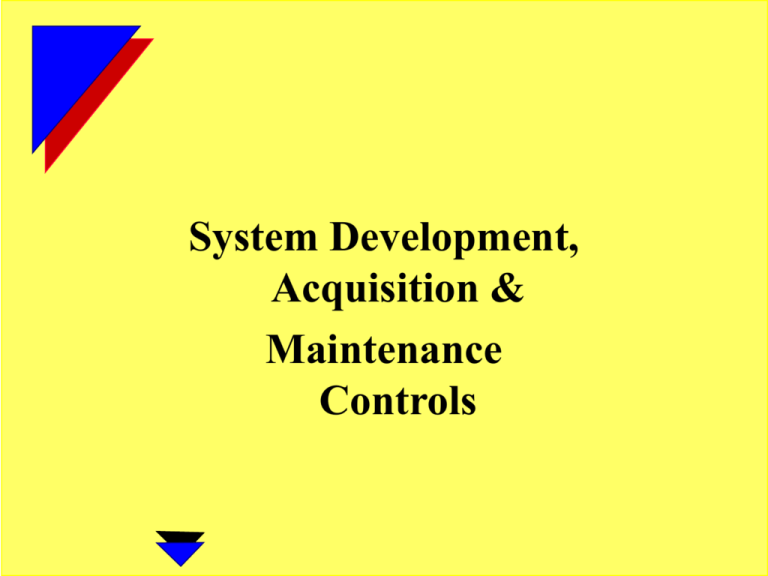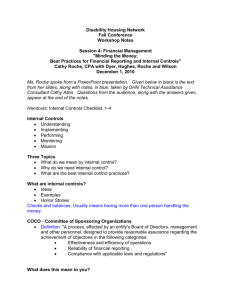m10w13SDLC
advertisement

System Development, Acquisition & Maintenance Controls Why Is Formal SDLC Necessary? Management – Avoid costly disasters – Competitive Advantage Auditors – Important element of internal control – Audit assurance on applications Why Is Formal SDLC Necessary? • Allstate - rather than 5yrs - $8 million ended at $100 million • Oklahoma - $500,000 workmen's comp ended at $4 million • Blue Cross & Shield - $200 million system didn't work - $60 million in overpayments lost 35,000 members Why Is Formal SDLC Necessary? • Gartner Group survey (J of A, Feb 2001) found: • 40% of IT projects don’t produce intended results • Typical project scheduled for 27 weeks • Cancelled project lasted 14 weeks, costing $1 million on unsatisfactory results • Project team members knew they were working on projects that would fail 6 weeks before cancellation -Mum effect; Deaf effect Why Is Formal SDLC Necessary? • Standish Group survey (CACM, April 2001) found: • 26 % of IT projects delivered on time, on budget and with promised functionality • 46% completed over budget and behind schedule, and with fewer features • 28% not completed Common Causes of System Failure • • • • • • • • Lack of user involvement Inadequate planning and budgeting Mismanagement of available workers Poor or incomplete design Insufficient testing Undocumented or unenforced development standards Lack of security over data and programs No change or project management function Systems Development Life Cycle Investigation Maintenance Implementation Requirements Analysis & Initial Design Acquisition/ Development Capability Maturity Model • Applicable to organizations in software business • The capability maturity model identifies 5 levels of software process maturity • Maturity level is a well-defined evolutionary plateau toward achieving a mature software process Capability Maturity Model Initial (1) + Disciplined process Repeatable (2) +Standard consistent process Defined (3) + Predictable process Managed (4) + Continuously improving process Optimizing (5) Project Management • Initiation - prelim survey, feasibility study, prioritization, resource allocation • Planning - objectives, deliverables, methods, activities, staff, budget • Execution - implement plan, manage personnel, quality control, communication • Control - monitor activities, controls, quality; report • Termination - transition Stages of Development Investigation Phase • Determine problem and whether a new/modified system is needed • Decision needs to be in accordance with policies, need to determine costs, savings and benefits • Problem ID and Initiation - have users involved to reduce semantic gap - different perceptions from reality, need to manage resultant change Stages of Development Investigation Phase • Preliminary survey - assess problem, needs, alternatives, system costs system benefits • Feasibility study - documentation of system review, hardware/software, transaction streams. Assessment of existing procedures Stages of Development Requirements Analysis & Initial Design Phase • Requirements analysis = Meet User Needs – – – – Observe users/functions, documentation Assess why each step performed What info used by each user What else needed Stages of Development Requirements Analysis & Initial Design Phase • Initial Design = Functional Specifications – Output – Input – System processing Stages of Development Acquisition/Development • Strategic Decisions – Make vs Buy – Outsourcing vs In-House Stages of Development Acquisition/Development • Detailed design specifications – – – – – – – – outputs, media and methods, file content, access methods, retention, back-up processing steps, modes, functions data preparation/entry hardware/software testing plan implementation plan documentation – control requirements • completeness, accuracy, authorization, timeliness, audit trail Stages of Development Acquisition/Development • Systems/programming standards - approvals and testing, control over conversion, stages of system development, required approvals at each stage, conventions to be used, testing and system documentation • Documentation - for clear understanding and safeguard when turnover occurs Stages of Development Acquisition/Development • System testing - not discrete but throughout the process – – – – Code inspection String testing Performance/load testing Pilot testing - large volume of test or live data and carefully check results – Parallel testing - data processed under new and old systems – Acceptance testing - hands on by users, system works right, recoveries of data timely, no lost messages, response times met Stages of Development Acquisition - Additional Steps • • • • • • Screen what is available RFP Evaluate potential suppliers Test/evalaute Negotiate agreement Install Stages of Development Implementation • • • • • • Scheduling conversions Site preparation Personnel recruitment and training File creation or conversion Implementation Post-implementation review Stages of Development Implementation • Conversion: – Conversion Plan (steps, responsibilities, timing) – Verification of: • • • • Completeness Accuracy Authorization Cut-off Stages of Development Maintenance • More than 50% of a system’s life time cost is incurred in the “Maintenance” phase • Need control over subsequent changes • Emergency changes - segregation of duties to prevent fraud Auditor Participation in Phases of System Acquisition/Development • Investigation phase - review economic feasibility analysis, ensure responsibility for control and audibility established • Design phase - correction and reprocessing of rejected transactions, changes to master file info, accuracy of programmed accounting procedures Auditor Participation in Phases of System Acquisition/Development • Development - review progress reports - cradle to grave test • Implementation - review pre-implementation plans monitor conversion procedures • Maintenance - instill control consciousness adequacy of program change controls Role of Auditor Assess Internal Control • • • • • Help everyone understand importance Look at compliance with procedures Assess effectiveness Database administration controls Assess security Role of Auditor Adequacy of Mgmt and Audit Trails • Make sure information is accessible • Make sure adequate trail exists Role of Auditor • Accounting Principles - new principles could be adopted - for example a new inventory method • Link between Mgmt and IS - auditors can be liaison • System conversions - concern with data accuracy proper-cutoff Role of Auditor Monitoring Compliance with Sys Dev Stds • Adherence to standards results in controlled auditable systems • Assess appropriateness of control practices • Verify adherence to policies • Review design, development and implementation of application controls Role of Auditor Post-Implementation Reviews • Compare system performance to objectives • Assess reliability and accuracy • Verify compliance with application controls • Assess applicability and usefulness of information Issue of Auditor Independence • Balancing act - give advice but client makes decision • Use 2 different audit teams • In written report clearly state scope of review • Standardize the scope and approach of review





